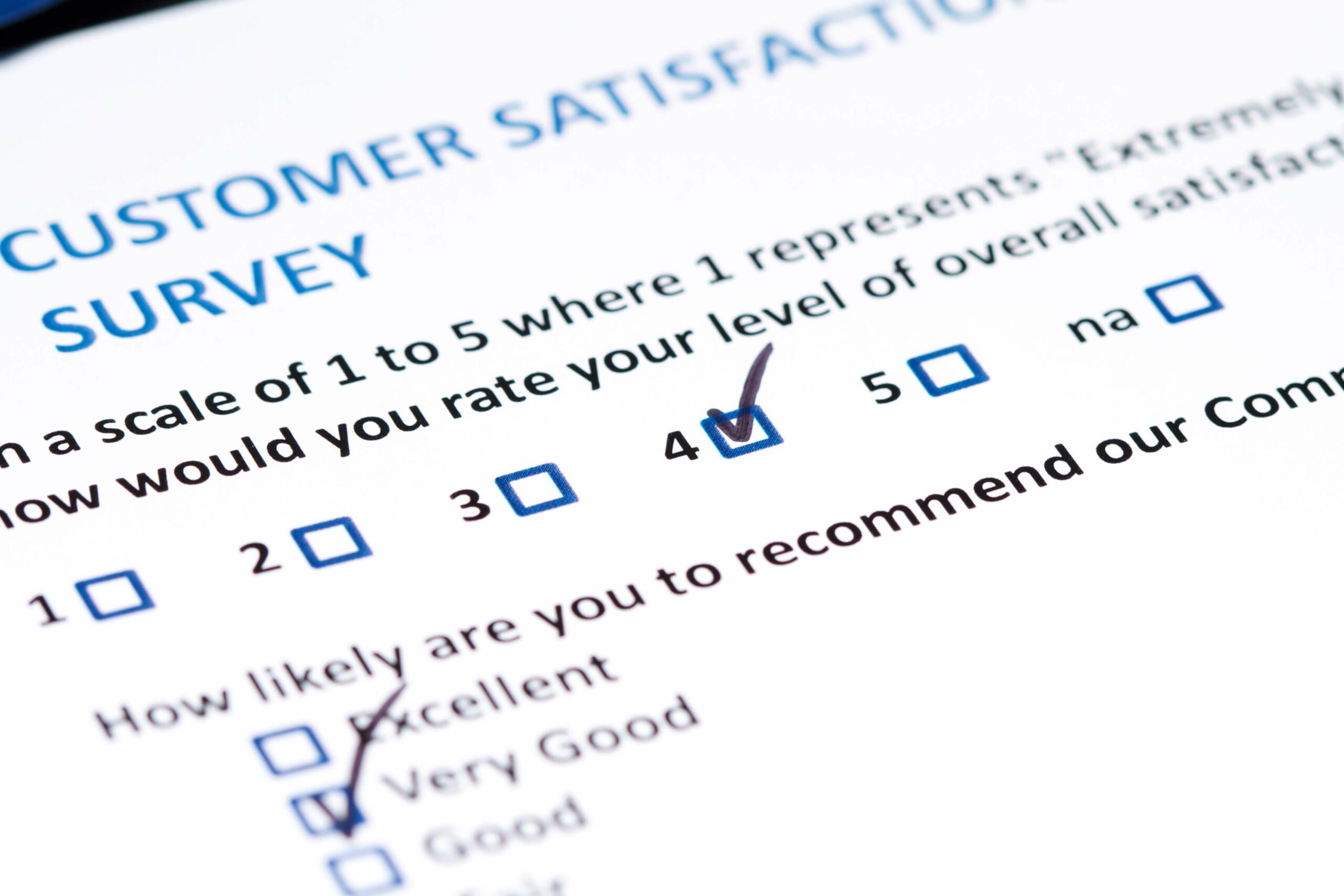Net Promoter Scores & NPS Surveys
Shipped
on
May 3, 2023
When it comes to customer experience metrics, Net Promoter Score (NPS) is the industry standard. Created by Fred Reichheld, the Net Promoter Score gives your company insight into their perception of your company, product, or service and their likelihood to recommend your business to others. Keep reading to get an in-depth look at the Net Promoter Score, the mechanics behind it, and how your business can utilize it to improve customer loyalty.
Online NPS Surveys
The Golden Rule of Business dictates how any company should treat a customer to create a good experience, which will, in turn, fuel customer loyalty. How does a business gauge satisfaction among its customer base? A keyhole way is through online NPS surveys. NPS survey scores will provide information about customer attitudes towards your organization to quickly assess your product. NPS scores make determining internal performance and external benchmarks easy and effective for comparing with industry competitors.
Net Promoter Score Definition
NPS, or Net Promoter Score, is a metric that measures customer loyalty to a company via a customer experience program. NPS is calculated is through a single-question survey, yielding a number score between -100 and +100. The higher the score, the better.
NPS® has long been considered a gold standard in customer experience metrics. This software, first developed in 2003 by Fred Reichheld, has helped millions of organizations track clients’ perceptions of their company. NPS scores can differentiate between negative experiences and positive feedback, which is measured with one ultimate question:
“On a scale from 0 to 10, how likely are you to recommend this product/company to a friend or colleague?”
Net Promoter Score Scale: Detractors, Passives, Promoters
Your Net Promoter Score system is typically broken up into three categories: detractors, passives, and promoters. Unhappy customers who have given a score of 0-6 are called detractors. They may harm your brand and impede growth by spreading negative word-of-mouth feedback. Detractors are unlikely to be loyal to your company, repeat punches, or recommend your organization to others.
Passives are generally satisfied customers but lack brand loyalty and may be persuaded by competitive offerings. Promoters are enthusiastic brand loyalists who will repeat purchases and recommend your organization to others, and more promoters mean more loyal customers and more positive word-of-mouth marketing. Customer satisfaction directly correlates to the number of scores among each group.
Promoters, also referred to as brand evangelists or brand ambassadors, are the people who love your company and will continue to use it. They’re the true power for improving customer service, increasing products and offerings, and growing your business. When you know how many promoters your business has, you can look at ways to increase the number by incentivizing loyal customers to stay with you and making their experience better than ever.

How Do You Calculate Net Promoter Score?
Net promoter score calculation is easy. When performing your organization’s NPS calculation, focus only on the percentage of detractors and promoters. Simply subtract the surveys with a score between 0-6 from those between 9-10. For example, let’s say your surveys show these percentages: 10% of detractors, 30% passives, and 60% promoters; your score would be 60-10= 50.
What is a Good NPS Score?
Considering the score range, -100 to +100, anything above 0 could be considered good because it reveals the number of promoters outweighs the detractors. However, most high-end organizations typically have an NPS of at least 70 or greater. This isn’t always the case for massive, global companies; for example, Netflix has an NPS of 60, PayPal 67, and Amazon 59. An NPS of 100 would mean that every survey respondent would recommend that company, a feat that has yet to be achieved.
How to Read a Net Promoter Score
There are a few things to know when it comes to reading your Net Promoter Score: these scores can vary across categories, they are real-time metrics that need to be reviewed daily, and their value isn’t in the number score but the feedback provided. Since your organization’s NPS can differ across customer categories like gender, age group, short-term customers, etc., a great starting point is with general information.
As you advance, you can begin to implement a segmentation system to tailor your approach across these categories. Once you get in the habit of reviewing the Net Promoter Score NPS data daily, you’ll start to notice fluctuations and trends emerging, which can be useful in creating future benchmarks.
Transactional vs. Relational NPS Programs
There are two types of NPS programs you can implement, relational and transactional. The Relationship NSP Survey is conducted monthly, with the aim of having consistent periodic contact with your customer base in an effort to understand their experience with your product. This data will help determine current business effectiveness and provide future benchmarks.
The Transactional NPS survey is sent only in cases of direct client contact, i.e., purchases or support calls. Generally, this helps with understanding customer satisfaction and provides feedback about those specific instances. Organizations should utilize both programs to understand their customer on a macro level.

How Can the Net Promoter Score Work for Your Business? How to Increase NPS?
Calculating your Net Promoter Score alone isn’t sufficient for promoting long-lasting benefits to your organization. The NPS is intended to form an ecosystem that encompasses the entire organization. NPS will allow you to track scores across your company with storefronts, websites, individual products, and more. It can be used in conjunction with industry NPS benchmarks to reveal how your company is performing compared to your competitors.
Loyal enthusiasts or customers in the Promoter range are the backbones of any business, and they’re very important in determining your NPS. A successful NPS score can be achieved by measuring customer loyalty and understanding what drives the behavior, gaining feedback from unenthusiastic customers (passives) on how to improve their experience, and responding quickly to their needs. This helps create a more engaged customer base that is likely to remain loyal and refer others.
Act on Net Promoter Score Feedback
As mentioned earlier, the Net Promoter Score methodology provides an overview of your customer’s opinion. However, the real value of the NPS is derived from customer comments. Analyzing and creating an action plan based on survey feedback will help to catapult business growth and ensure an improved NPS in the future. Considering detractor scores and comments and preventing negative word-of-mouth feedback among customers can also help to improve or promote services and products.
Should You Use NPS to Survey and Measure Employees (eNPS)?
Most Net Promoter Score surveys are intended to collect and evaluate customer feedback but can also be used as a tool to determine employee sentiments. NPS measures how likely your workers are to refer your company to prospective employees. According to Qualtrics, companies should avoid using eNPS to calculate employee satisfaction, but rather they should use a more exhaustive surveying methodology, like employee engagement surveys. eNPS lacks complexity in comparison due to its single-question approach.
How Do You Create an NPS Survey?
It is relatively simple to create NPS Survey Templates, but you have to take into account the data used to determine the best way to administer them. If you use software to conduct a survey, you may be restricted from taking action based on the results since it only measures a single metric. Customer Experience Manager Software or NPS Software like Satmetrix Systems will help you gain a complete picture of your customer base. Customer experience management platforms allow you to keep account of every interaction between your business and your customer. This data will help you to pinpoint which touchpoints are strong and which are weak.
The Net Promoter Score Question
The Net Promoter Score or nps question discussed earlier is the main way to measure your score. Other questions answered by respondents are used to better understand the initial feedback and follow-up.
Improve the Experiences that Impact NPS with Medallia
Medallia is a CX provider and market leader in assisting companies in understanding how customer experience affects their NPS score. Medallia provides insight into what turns promoters into passives or detractors. Through Medallia Experience Cloud, users can quickly compute scores and receive insight that will allow them to identify causes and take action to improve the quality of service. Understanding NPS will allow you to formulate a new business strategy to attract more clients who will advocate and ultimately generate revenue growth. Learn how Medallia has enabled business improvements in regard to NPS performance by implementing systemic practices focused on customer experience.
Permission to Follow Up With the Customer
Not all respondents will be willing to discuss their issue with your product; however, it is still vital to make an effort to follow up. Depending on the survey you provided, you may already have their contact information. If you’re asking a client for a telephone number, you can ask them if you want them to contact me. If not, don’t ask for their contact details if you are able to obtain this information with metadata from another website.
How to Run Surveys and Collect NPS Feedback
In order to track your NPS, you must first administer the NPS surveys that collect customer feedback. The way you do this depends on when you want to ask for feedback. You can collect feedback the instant a customer interacts with your organization or some time after.
Email survey
Instead of displaying a site pop-up, you can get NPS statistics by emailing customers and asking for their participation in filling out a survey. Email surveys do require some work on the customer’s end, and there is a delay between the time the survey is sent out and when the results are received, but it can afford your customer more time to become better acquainted with your product. The more time customers have to experience your product, the clearer they’ll be on whether or not they would recommend it.
Send an NPS Email to Collect More Responses
An NPS email allows you to embed the survey question in the body of the email, making it much easier for you to obtain customer answers and feedback on specific topics. NPS email is effective at getting more replies from users. A study found that embedding an NPS question within an email can raise the percentage of response rates by 22% and completion rates by 19%.

Spot Customers at Risk of Churn
Customer churn data can be coupled with customer experience metrics, like NPS, as a reliable predictor of when a customer is likely to churn. This will allow you to create a customer churn model without the work of advanced statisticians that will identify endangered or unhappy customers and have customer support follow up with them to gain customer loyalty. Creating this model using NPS links the experience and operation data, like renewal rates.
Progressive Direct, SurveyMonkey, and NPS
SurveyMonkey CX is a global leader in survey software, particularly in obtaining Net Promoter Scores. Progressive Direct, an online automotive insurance company, needed to measure satisfaction in the customer journey, so they turned to SurveyMonkey – CX. Progressive Direct’s head of Product and Services, Nick Bell, said the system allowed them to quickly and easily collect and understand customer pain points. With SurveyMonkey, Progressive Direct was able to reduce its business-driving decision time from months to weeks.
Frequently Asked Questions
What are the benefits of Net Promoter Score?
The benefits of a Net Promoter System are numerous. Tracking your NPS gives you and your customer service team the ability to monitor performance across your company and uncover opportunities for improvement. It can show you how your company is performing compared to your competitors. NPS will help you understand your target market or ideal customer base and their perception of your product or service, employees, marketing, etc., so that your company can take business-driven actions, ultimately gaining loyal customers who will promote your company.
Why does Net Promoter Score matter?
The Net Promoter Score is important because it can help a company predict its growth. When a company has a high NPS, it means they have a healthy relationship with their customer. A healthy customer relationship means brand loyalty and a greater likelihood that those customers will promote your product or service to others.
According to NPS benchmarks reports, the telecommunications industry has consistently delivered poor customer experience to both their B2B and B2C clients. This is evident from particularly large internet service providers like telecom maintaining an NPS average of 31, which is the lowest industry average. This score matters to the company’s reputation amongst its customers. Lower scores can directly correlate to the company’s growth, performance, profit, and success.
Why is NPS important for customer loyalty?
NPS lets you know how a customer thinks and feels about your company overall. A high score signifies a more than satisfactory experience with your company and indicates a high likelihood that those enthusiastic customers will be loyal to your brand. The more your company implements business-driving actions based on the feedback received through the NPS, the greater improvement it will see in measuring customer loyalty and overall customer sentiment. New customers and higher retention rates are just a few of the benefits that can be expected from successful NPS system management.
By understanding what creates customer loyalty, your company can use its NPS score to track the success of various efforts related to customer satisfaction. This will help you identify areas where improvements need to be made or processes that should be maintained.
Where can I find my Net Promoter Score?
You can calculate your Net Promoter Score on your own using a simple formula that subtracts your survey detractors from your promoters. You can also utilize one of many NPS platforms, like Qualtrics and SurveyMonkey, that will calculate your score for you and provide insight into your customer base and how they feel about your company.
What is the Starbucks NPS score?
At the time of this article, Starbucks has an NPS of 77.
Sources & Helpful Links:
https://www.qualtrics.com/experience-management/customer/net-promoter-score/
https://www.hotjar.com/net-promoter-score/
